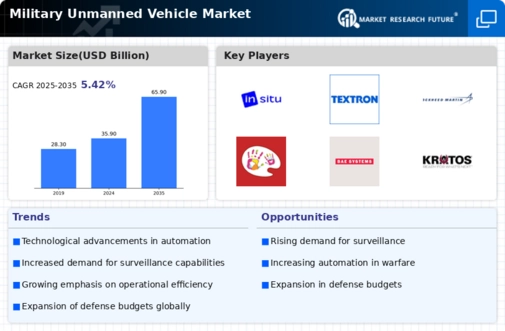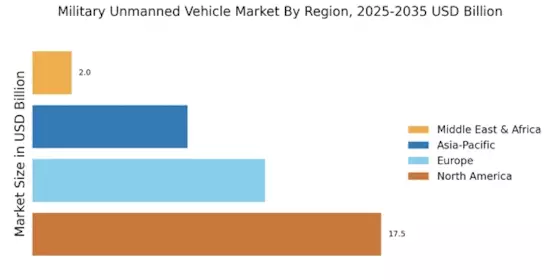Strategic Partnerships and Collaborations
Strategic partnerships and collaborations are emerging as a key driver in the Military Unmanned Vehicle Market. Companies are increasingly joining forces to leverage each other's strengths, combining expertise in technology, manufacturing, and logistics. These alliances facilitate the development of cutting-edge unmanned systems that meet the evolving needs of military clients. For instance, partnerships between defense contractors and technology firms are leading to breakthroughs in drone capabilities and operational efficiency. As the market becomes more competitive, such collaborations are likely to become more prevalent, fostering innovation and accelerating the deployment of advanced military unmanned vehicles.
Growing Demand for Surveillance and Reconnaissance
The Military Unmanned Vehicle Market is experiencing a growing demand for surveillance and reconnaissance capabilities. As geopolitical tensions rise, military forces are increasingly relying on unmanned vehicles to gather intelligence and monitor potential threats. Drones equipped with high-resolution cameras and advanced sensors are becoming essential tools for modern warfare. Recent statistics indicate that the demand for surveillance drones is expected to grow at a rate of 12% annually, reflecting the urgent need for enhanced situational awareness. This trend underscores the critical role that unmanned vehicles play in contemporary military operations, driving further investment and innovation in the sector.
Increased Investment in Military Unmanned Vehicle Market
Investment in the Military Unmanned Vehicle Market is on the rise, driven by the need for enhanced defense capabilities. Governments are allocating substantial budgets to develop and procure unmanned systems, recognizing their strategic advantages. For example, the U.S. Department of Defense has earmarked over USD 7 billion for drone technology in its latest budget proposal. This influx of capital is fostering innovation and competition among manufacturers, leading to the development of more sophisticated unmanned vehicles. As nations seek to modernize their military forces, the trend of increased investment is likely to continue, further propelling the growth of the market.
Technological Advancements in Military Unmanned Vehicle Market
The Military Unmanned Vehicle Market is experiencing rapid technological advancements that are reshaping its landscape. Innovations in artificial intelligence, machine learning, and sensor technologies are enhancing the capabilities of unmanned vehicles. For instance, the integration of advanced navigation systems and real-time data processing is enabling these vehicles to operate autonomously in complex environments. According to recent data, the market for military drones alone is projected to reach USD 20 billion by 2026, reflecting a compound annual growth rate of approximately 10%. These advancements not only improve operational efficiency but also reduce the risk to human life, making unmanned vehicles an attractive option for military applications.
Focus on Autonomous Operations in Military Unmanned Vehicle Market
The Military Unmanned Vehicle Market is witnessing a pronounced focus on autonomous operations, which is transforming military strategies. The ability to deploy unmanned vehicles that can operate independently reduces the need for human intervention, thereby enhancing mission efficiency. This shift is particularly evident in surveillance and reconnaissance missions, where autonomous drones can gather intelligence without risking personnel. Recent estimates suggest that the market for autonomous military vehicles could exceed USD 30 billion by 2027, as more nations recognize the operational advantages of these systems. The emphasis on autonomy is likely to drive further research and development in this sector.


















Leave a Comment